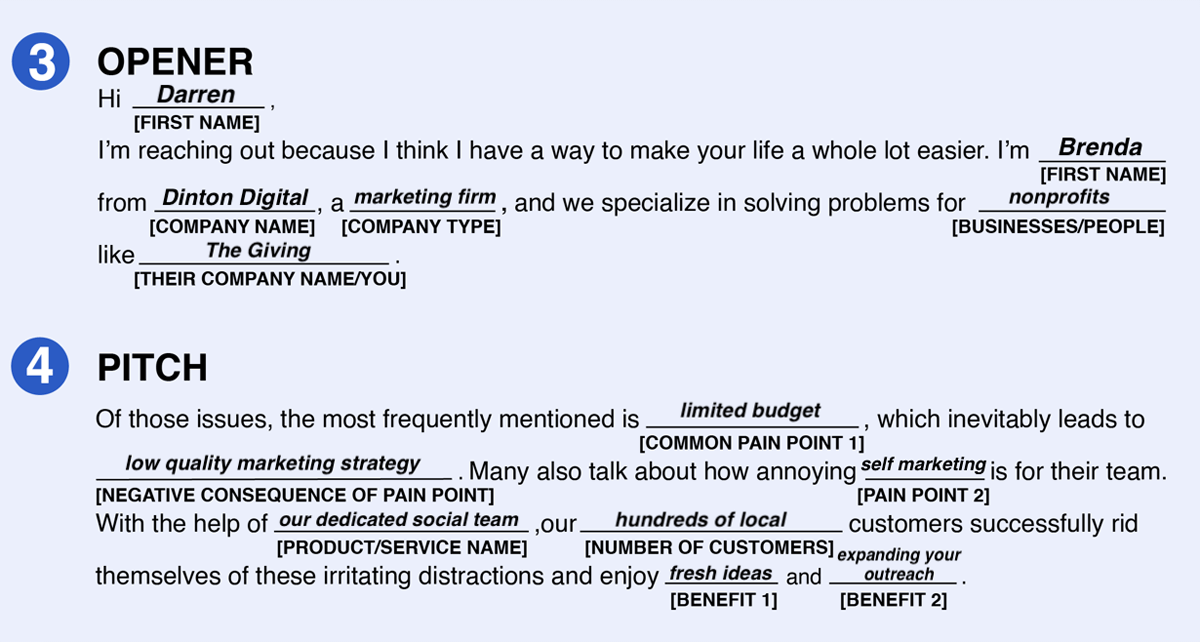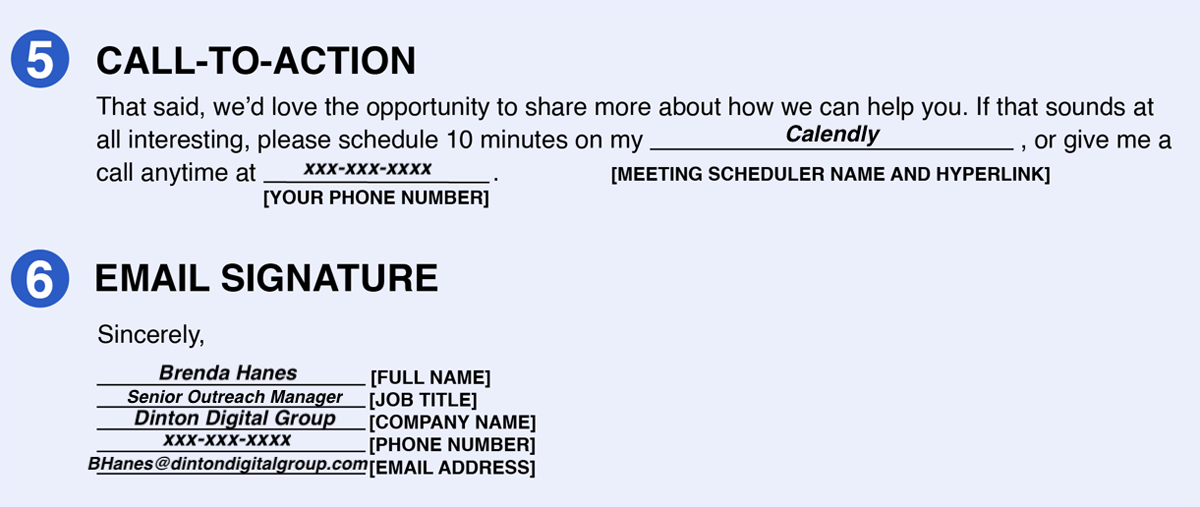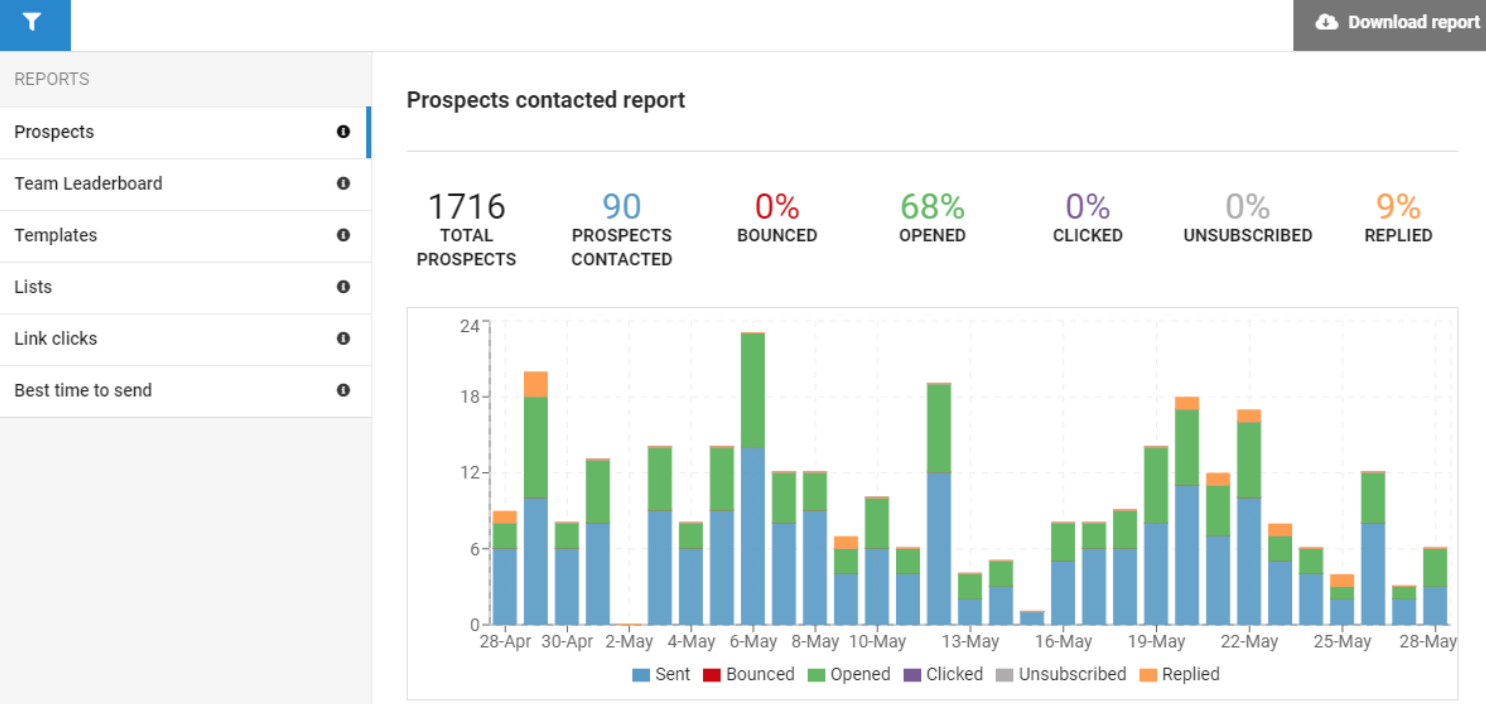Learn the differences between leads, prospects, and opportunities. Understand how to turn leads into prospects and opportunities.
Cold emails are introductory messages that salespeople send to cold leads to pitch a product or service and inspire an action — typically scheduling a sales call. To write one, salespeople research their lead and write an email that focuses on 1–2 relevant pain points and how their solution can resolve the issue. Knowing how to quickly and effectively craft a personalized cold email will help you generate more leads for your business.
We created a free cold email template to help you efficiently write a cold email with the ideal structure. You can download it along with 12 niche-specific examples below. The template includes effective verbiage that you can tweak as well as blanks you can fill in to tailor each email to your specific needs. The template also contains the vital format of any cold email:
For detailed steps on the format of a cold email and how to fill out your template, check out our article on the best cold email template and format. Below, we’ll break down each step of writing a cold email, from preparation to follow-up. Follow them to fill out your template or to create a cold email from scratch. Regardless, try to keep your cold email to under 200 words. If you go over that limit, your email should be highly personalized to the recipient.
Here, we’ll show you the step-by-step process for writing a cold email that’s personalized, engaging, succinct, and therefore effective at getting replies from cold leads. The preparatory work involves getting the lead’s email address and researching them. Then you’ll write an email that creates desire and action. Finally, you’ll follow up and track the results.
Here are the nine steps for writing a cold email that works:
Now, let’s dive into the comprehensive descriptions of each step. After reading, you’ll walk away feeling confident that you have the power at your fingertips to get positive replies from some of the busiest decision makers out there.
You can find your leads’ email addresses in a variety of ways. The most cost-effective options are email finder tools or manual research, and the most expensive but efficient option is paying a lead generation company to find leads and their information for you. The time you save and data accuracy is often worth the cost.
Here are the main ways salespeople find leads’ email addresses:
Try out each of these methods, and choose one or a few to use simultaneously according to your business and resources. To avoid sending your well-crafted cold email into the ether, it’s worthwhile to create a verification process using an email verification tool. Doing this credibility check and research before even crafting the email improves your efficiency in a sometimes daunting task.
Conduct online research of your lead’s social profiles, company website, and personal website to learn about them. Also consider doing a reverse email lookup. Overall, this shouldn’t take more than five minutes. Just a little research can make a huge difference in the level of personalization of your cold email, which will make the email more interesting to the lead.
During research, look for the following pieces of information:
Of the above, the most crucial element is a relevant pain point to include in your email copy. This is a probable issue according to their role, company details, and other information. When you actually start writing the email, you should mention this relevant problem in your subject line to get their attention, and you should also reiterate it at the beginning of your pitch section.
A cold email template is a prewritten cold email that contains blank fields you’ll fill in to tailor the message to your business and the lead. About 75% of the email prose will already be written, but, just like the blanks, you can edit the writing to make it better fit your situation. Templates can speed up the drafting process and give you guidance on what to include in your cold email.
Here’s the typical outline of a cold email (and hence a cold email template):
When you use a template, you can be sure to include all necessary components. You’ll also be able to write your cold email more quickly since most of the verbiage will remain the same, and you can simply personalize it for each new lead you contact.
The from line is the first thing the recipient sees, so make it count. Your from line dictates how your name appears in the recipient’s inbox before they click on the email. Its default setting is usually your full name, but we recommend changing it to something more personable, like “{First Name} from {Company Name}.” This makes you seem more human.
You could also use the following from lines:
As for length, keep it to a maximum of nine words or 50 characters. You don’t want it to be cut off. Also, always include at least your first name to avoid confusion. You can change your from line in the account settings of your email provider. Here’s an article detailing how to change your from line in Outlook, and here’s one for changing the from line in Gmail.
Here’s an example of the from line from our template:

Now that your recipient knows you’re not a robo-spammer, grab their attention with your subject line. A good subject line is personalized and short (no more than 10 words or 60 characters) and teases the content of the email. Most importantly, it convinces the lead that the email is meant specifically for them. Do this by including their name, pain point, company name, or another relevant piece of info.
A good starting point would be to try these three subject lines:
The subject line example from our template follows the structure of the first bullet point above:

Like the example above, posing a question is a great way to make an engaging subject line. This approach creates natural interest while also forcing you to use casual language and tease your pitch. However, the best way to find the right subject line is to A/B test different ones and measure their open rates so you know which resonates with your target audience. In step nine, we’ll have more on tracking results and optimizing the components of your email.
Your introduction and pitch should make up about 75% of your cold email’s body — anywhere from 125–200 words. However, the more personalized these two components, the longer you can make it. People have longer attention spans when reading about themselves. Let’s look at how to write your introduction first and then your pitch.
To write your intro, begin with a proper greeting. Stick with “Hi/Hey/Good evening, {First Name},” and shy away from anything too formal. Next, state your name, company name, and the reason you’re reaching out. Also, make it clear that this email is meant for them. The best way to do that is to include something about the lead in the first sentence, like a recent promotion or a hobby you share. If that’s too hard to find, their company name or job title will do.
After you’ve introduced yourself, it’s time to make your elevator pitch following these five steps:
Below is an example of the introduction and pitch from our cold email template:

Finally, write your call-to-action (CTA) and sign the email. Here, you’re asking the lead to take specific next steps with you, then ending with a respectful sign-off and giving all the ways to reach you. Let’s look at each of these separately, starting with your CTA.
When writing your CTA, keep in mind that the typical goal of a cold email is to land a 5–10 minute discovery phone call during which you’ll learn more about the lead to see if they’re a good fit and tell them a bit more about your solution. An example of a CTA could be “Are you free for a five-minute phone call on Monday at 2 or 3pm to learn more?”
Here are some tips for writing your call-to-action:
Your signature includes your sign-off (e.g., sincerely, all the best, thanks) and your contact information under it. At a minimum, include your email address, job title, phone number, and company name in your signature so the lead can easily reach you. If you’d like to go above and beyond, consider linking out to testimonials, case studies, or portfolio pages to build credibility.
Here’s the example of a CTA and signature from our cold email template:

Sometimes, leads don’t respond the first time just because they put it aside for later or forgot. So follow up until you get a reply or have sent three emails. This increases your odds of getting a response. Best practice is to wait 3–4 days between each email so that you don’t bother the lead. This persistence shows confidence in yourself, your business, and your product or service.
When writing your follow-up emails, follow this procedure in order:
Now, if the lead never answers, make a note in your CRM and reach out again in a few months in case their situation changes. Also consider placing the lead into an email nurturing cadence where they’ll receive emails (likely from your marketing team) related to their location in the customer journey. Then, you can reach out again when they’re warmer or have even engaged with those emails.
In your CRM software, track metrics related to actions your recipients take when they receive your email. Use these metrics to guide you in your experimentation and A/B testing of the different components of your cold email. For example, send 200 emails that have the same body but use one subject line for 100 of the emails and another subject line for the other 100. Then you can compare which had the best open rates.
Here are the sequential steps for tracking key metrics and improving your cold emails:
Different metrics matter for different tests. When testing a new subject line, you would look at its open rates to gauge its level of success. If testing a new pitch or CTA, you’d focus on the reply rates. Consistently attempting new messaging, tracking the results, and iterating is the best way to reach a cold email that works repeatedly.
To help you visualize these analytics, below is a shot of SmartReach’s cold email metrics:

Cold email examples are treasure troves of inspiration and strategies that you can test out in your own cold emails. Below you’ll find four examples we’ve created: B2B software solution, B2C service, B2C product, and B2B service follow-up. We’ll also dissect the emails and tell you what specifically works in each.
The seller in the email above is trying to build interest in a B2B SaaS product that helps improve lead qualification. The email begins by building rapport, mentioning something the seller and the lead have in common — a relationship to a place. It then jumps into a common pain point of people in the lead's position.
Next, the email mentions the solution to this pain point and shares a metric about the improvement the lead can expect to see. It ends by making a straightforward request to get some time on the calendar. This email closely adheres to our recommended outline and can be used as a good reference for those writing B2B product emails.
The seller in this example is attempting to set up a consultation for their gutter cleaning service. The email does a great job of highlighting the reasons why gutter cleaning is so important as well as the pain points associated with actually cleaning it, thereby creating a need for their service. It also has a clear CTA offering two ways for the lead to comply.
Although the email’s structure slightly varies from our template, it still includes all the vital elements. Instead of building rapport and introducing the company, the introduction serves the purpose of explaining why it’s so crucial to clean out gutters. Let’s assume the recipient is a new homeowner — if so, this would be a good example of tailoring the email to the recipient’s awareness level.
With B2C product cold emails, you run the risk of seeming spammy or inauthentic. This cold email example does a good job of coming across as genuine and credible by mentioning research they did on the lead and by including a link to their testimonials and scientific studies pages. The email also focuses on naming a problem the recipient likely has.
The email follows our recommended structure to a tee, including a catchy subject line, a personable introduction, a problem-oriented pitch, and a direct and straightforward CTA. Also, portraying the pain points in a bullet list is a nice touch that makes it scannable for the lead.
The above email is an example of something a B2B service salesperson might send to follow up on their first cold email. It’s short and to the point and attempts to build confidence in the lead by sharing a case study with real numbers to back up claims about their value they likely made in the first cold email.
On another note, this follow-up email closely follows our recommended outline. It first reminds the reader of the first email you sent to give them context. It then goes on to add more to the conversation by sharing a customer success story about a company similar to the lead's. Lastly, it makes another clear call-to-action to try and schedule time on the phone.
These four examples show how to cater your cold email to specific scenarios while presenting a strong understanding of your lead’s pain points and potential solutions through a conversational tone. Consider using any of these examples as a template or inspiration when writing your own cold email along with our top tips below.
Regardless of who’s receiving your email, they’ll be more likely to respond positively if you follow a few cold emailing best practices. The most successful salespeople typically personalize their cold emails for the lead who’ll be receiving it, along with AIDA, and an overall strong attention to detail. Below are the key tips for you to keep in mind:
If you’re looking for more some actionable advice explained by sales and business experts, check out our article on cold emailing tips. There you’ll learn how to prep for and write the email, perfect your tone, and follow up like a pro.
A cold email should be between 50–200 words in length. More succinct is better. Buyers are busy and lose attention easily. However, as a general rule, the more personalized your email, the longer the email can be. When a lead is reading about themselves, a pain point they hate, and a solution that seems perfect for them, they’ll read the whole thing even if it’s 350 words.
As a rule of thumb, you want your cold email to sit near the top of their inbox while they go through their emails. Most business professionals handle this task early in the morning, meaning the best time to send a cold email is typically between 8 and 10am. And the best days to send it are Monday through Thursday because by Friday many people have mentally checked out.
However, the time and day that will get the best cold email results depend on your target audience. The only way to find the exact time and day that gets the most conversions is by tracking your email metrics in your CRM. Over time, after you or your company has sent thousands of cold emails, you’ll start to see trends.
A personalized, relevant, and interesting cold email is a great lead generation strategy to begin a sales conversation with a potential customer. To do so, research the lead, write an introduction, make a personalized pitch related to their pain points, and ask them to take next steps. With our process above you can confidently craft your own cold emails, but if you’re wanting a ready made template and tips check out our article with cold email templates for any scenario.